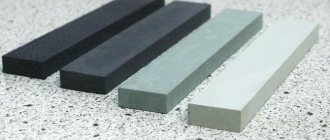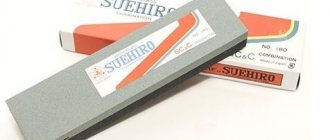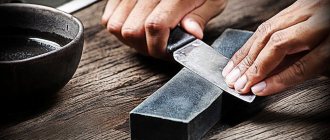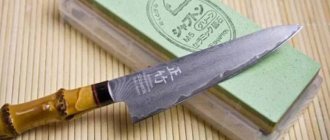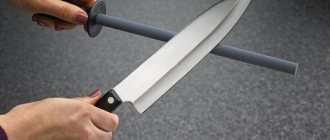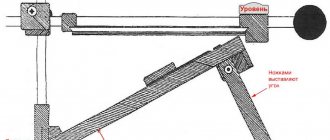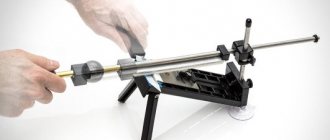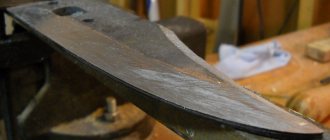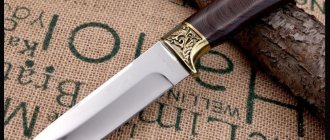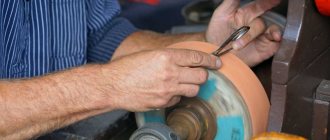Sharpening stones are multifunctional tools; they are needed for repairing, straightening and sharpening devices that have a cutting edge. They cope excellently with such tasks as sharpening, since the force and intensity of manual processing are selected independently, unlike electric machines, which operate at high speeds and, due to a small mistake, can ruin the entire product. Another advantage of the bars will be their modest dimensions, thanks to which any tourist, fisherman or hunter can have them with them.
Stones for sharpening knives.
Classifications of whetstones
The first sharpening stones were used by humans in ancient times. For example, to restore the cutting properties of their scythes, peasants used special bars called whetstones.
The sharpening stone acquired a more or less modern appearance during the Soviet era, when special markings began to be applied to it. This was forced by adjusting all manufactured products to general standards.
The bars of that time had the following data:
- manufacturer's mark;
- product type;
- dimensions;
- grain;
- material of manufacture;
- technical properties;
- accuracy class;
- GOST standard.
According to their type of origin, sharpening stones are divided into 2 groups:
- natural;
- artificial.
Natural whetstones
Mines of natural abrasives can be found in Belgium, Germany, Turkey, Japan, and the USA.
Made from Arkansas stone
Novaculite from Arkansas has become widespread. It is a homogeneous white mineral with a yellowish or bluish tint. The peculiarity of quartz lies in its structure: it consists of 99.5% silicon oxide.
The formation conditions of the layers determined the characteristics and dimensions of the material and made it possible to distinguish the following types of fractions: hard, medium, soft. The main type of novaculite has a fine-grained structure within 1-6 microns, with each fraction resembling a tooth and their boundaries growing into each other, forming a durable grinding coating.
Arkansas stone knife sharpener.
Varieties of Arkansas abrasive are characterized by lower hardness, which is explained by larger grains and greater porosity of the minerals.
During mining, washita stone is often found to be black, brown or gray in color. It is inferior in strength to soft Arkansas, but remains in demand due to its low price.
Made from Japanese water stone
Japanese water stones, which have been mined in the vicinity of Kyoto for several centuries, are also used to make natural sharpening stones. Their main advantage is the fast, soft sharpening of the tool to razor sharpness.
Before use, the products are soaked in water for 5-30 minutes until air bubbles stop escaping from them. This is necessary to ensure that the pores of the instrument do not become clogged with metal dust. Coarse-grained stones for sharpening knives are soaked for 5 minutes, fine-grained stones should be kept in water for at least 15 minutes.
The disadvantages of abrasive include:
- high cost;
- the need for constant lubrication;
- quick grinding, requiring regular alignment.
Sandpaper is placed on a plate of marble or glass, and then they begin to carefully grind down the stone.
Synthetic stones
Artificial whetstones for sharpening knives are made from particles of silicon carbide or electrocorundum, soldered to a binder material by applying pressure and high temperatures. Among other types of whetstones, they stand out for their low price and availability, but they quickly wear out.
Bars made of synthetic water stone.
The combination of grain calibration and binder quality serves as an indicator of product reliability. Inexpensive grinding models have a non-uniform grain surface and low quality binder, so they quickly lose their appearance, requiring frequent leveling.
Tools with a medium grain grind down slowly, samples with a fine-grained structure practically do not wear out, but are quickly covered with metal particles. Therefore, after polishing, such stones are rinsed with soapy water.
Water stones of synthetic origin are obtained from carbides and oxides of silicon, chromium, and aluminum. The main requirement for their manufacturing technology remains careful sifting of the basic elements. The content of particles of different sizes in the structure affects the quality of sharpening stones.
Ceramic or bakelite elements are used as a binder, which differ in the degree of hardness of the finished product.
The use of expensive raw materials increases the cost of water-based abrasives. It is higher than that of artificial analogues, but lower than that of natural instruments.
Diamond bars
The products are complete analogues of stones; they have different configurations and grain sizes, which makes them possible to use in various everyday situations. Most often, diamond stones are sold on stands or in the form of narrow bars.
Diamond bars have different configurations and sizes.
The main advantage is the high sharpening speed, so during processing you can use special holders that will not allow you to damage the knife. In order to make the blade sharper, the knife is ground again with an abrasive made of a different material.
The high efficiency of coated sharpening stones makes it possible to reduce the length of the product by 1.5 times, which explains the demand for pocket diamond sharpeners.
The surface of the whetstone for knives wears out slowly, and even the fragment that has lost its abrasive properties remains flat.
Ceramic bars
The products combine the advantages of natural abrasives and the strength of diamond bars. They are made from a material that has much in common with ceramics for microcircuits. Most often, these types of stones are used only for editing and finishing knives. They are not wetted during operation, but after use they are immersed in water for rinsing. The shape of ceramic stones allows you to sharpen not only knives, but also fishing gear (needles, hooks).
Grit of sharpening stones
It should be noted right away that even amateur sharpening on stones is far from simple. Those who have never used such abrasives may encounter certain difficulties at the very beginning of their journey - choosing a “tool”. What grit size of stone is needed for sharpening knives? Let's try to fully cover this topic, putting everything into detail.
The very first question, the answer to which will help you choose the right stone for knives, concerns the grain size, it is also called grit. The aggressiveness of the impact on the metal directly depends on the value of this parameter.
Large grains leave deep chips and gouges on the surface, which is unacceptable. An ideal job is considered to be a smooth, sharp, mirror-like cutting edge without any defects. That is why large grains are used only for working with workpieces, that is, processing a newly forged blade, or for restoration. Fine grains are responsible for grinding and final polishing. True, working with this stone takes an order of magnitude longer, but the result is worth it. Medium grain sharpens if the blade is slightly dull.
In your kit, it is advisable to have a minimum, if you sharpen infrequently or are just learning, three double-sided stones: with very fine grain, medium and coarse. It is worth working, moving from large to small.
Water stones for sharpening knives of various grain sizes.
Grit and Roughness Table
This table contains all the necessary information that will help you understand the different types of stones: markings, grain size, roughness and purpose.
| Class | Average grain size, microns. | Grit | Russia | Purpose | ||
| Japan (watermen) | USA | Germany | GOST 9206-81 (diamonds) | |||
| 14 | 0,025 | — | — | 0,1/0 | Editing and polishing, super finish | |
| 14 | 0,05 | — | — | |||
| 13 | 0,07 | 200,000 | — | |||
| 13 | 0,1 | — | — | |||
| 12 | 0,15 | 100,000 | — | 0,3/0 | ||
| 12 | 0,25 | 60,000 | 100,000 | |||
| 11 | 0,49 | 30,000 | 60,000 | 1/0,5 | ||
| 10 | 0,74 | 20,000 | 20,000 | |||
| 10 | 0,91 | 16,000 | 16,000 | |||
| 9 | 1 | 15,000 | 14,000 | 1/0 | ||
| 9 | 1,5 | 10,000 | 10,000 | 2/1 | ||
| 9 | 2 | 8,000 | — | F 1500 | ||
| 8 | 3 | 5,000 | 8,000 | F 1200 | 3/2 | |
| 7 | 5 | 3,000 | 4,500 | — | 5/3 | |
| 7 | 5,3 | — | — | — | 7/5 | |
| 7 | 7 | — | — | — | ||
| 7 | 8,5 | 1,800 | P 2500 | — | 10/7 | |
| 6 | 10 | 1,500 | — | F 600 | Removing grinding marks, fine sharpening and finishing | |
| 6 | 15 | 1,000 | P 1200 | — | 20/14 | |
| 6 | 18 | 800 | P 1000 | F 400 | ||
| 5 | 20 | — | — | — | ||
| 5 | 26 | 600 | P 600 | — | 28/20 | |
| 4 | 30 | 500 | P500 | F 320 | 40/28 | Removing traces of roughing operations, grinding |
| 4 | 35 | 400 | P 400 | — | ||
| 4 | 46 | 320 | P 320 | F 240 | 60/40 | |
| 3 | 53 | 280 | P 280 | F 230 | ||
| 3 | 68 | 240 | P 220 | F 180 | 80/63 | |
| 3 | 82 | — | P 180 | F 150 | ||
| 2 | 100 | — | P 150 | — | 125/100 | Roughing operations, intensive metal removal |
| 2 | 136 | 120 | — | — | — | |
| 1 | 260 | — | P 60 | F 60 | — | |
How to use musat
You can edit using musat in different ways, changing the location of the knife and tool. There are 2 classic techniques: suspended or supported on a surface. In both cases, the edge is processed on both sides of the blade alternately. The location of the cutting edge down or up also changes.
It is important to sharpen the knife correctly with musat: the blade should be located in relation to the rod at an angle of up to 20-30 degrees. Sliding at one level is less efficient than moving the working part of the knife along the entire length of the rod.
In midair
The method involves placing the tool in suspended position. The algorithm of actions is as follows:
- One hand holds the musat in a horizontal position.
- In the other hand there is a knife. The blade (from the handle) is applied with the tip up to the end of the rod.
- When the hand is moved down, the blade lowers and slides along the shaft towards its base (from the handle to the tip). Only the hand should move, because... When moving the knife, the likelihood of injury from the shifting tip increases.
- The hand holding the musat does not move.
It is safer to place the musat slightly downward (away from you). In this case, the blade is applied from the handle to the base of the rod at the guard. The knife is lowered so that its cutting part slides along the entire length of the musat to the tip. The risk of cutting yourself is minimal, because the movement is directed away from the hand with the tool.
The “In midair” position assumes that work with musat is carried out in weight without additional support.
Calmly
It is assumed that there is a support on which the musat is held vertically with the handle up.
Editing is carried out according to the following algorithm:
- The working part of the knife is applied with the base at the handle under the musat guard. The recommended angle is 10-15°.
- The hand with the knife is pulled back, while the blade slides down the shaft, moving towards the tip. The movements are reminiscent of cutting bark from a branch.
This is a safe method; causing injury with a blade is almost impossible. For support, it is important to choose surfaces that do not slip.
Main criteria when choosing a stone
Before purchasing a tool you must:
- Select abrasive material. In everyday life, ceramic products are more often used, for example, a boat-shaped block. A double-sided sharpener with a rough and smooth surface is often found. Diamond stones are rarely used in professional sharpening of kitchen knives. The high price limits the spread of natural abrasives.
- Pay attention to graininess. When sharpening, use bars with a grain size of 600-800 units. To polish the edge, bars marked 1500-2000 are used. Bars with a grain size of more than 2000 are intended for professional work.
- Consider the scope of use. The size of the block should exceed the length of the blade by 1.5-2 times.
Stones for sharpening knives made in Russia
The list of popular Russian-made sharpening stones includes products from the following companies:
- "Gritalon". This brand produces synthetic products for electric sharpeners and manual sharpening. The base material for abrasives is silicon carbide.
- "Petrograd". The grain size of the manufactured stones complies with the Japanese standard JIS-2017.
- Grinderman. The production was launched in St. Petersburg under the leadership of Andrei Petrov. The company produces and sells sharpening stones and means for their maintenance.
Popular foreign brands include Metabo, Samura, YOSHIKIN, Dan's, Lansky.
What is a grinding wheel
It is an abrasive tool for processing products both on stationary machines and using hand tools. There are several parameters by which grinding wheels can be classified.
For their manufacture the following can be used:
- silicon carbide;
- diamond of artificial or natural origin;
- electrocorundum;
- elbor.
Depending on the grain size, the discs differ in their purpose. Between the grains there is an adhesive and filling composition - a binder, which gives it abrasive properties due to the pores. The abrasive removes particles from the material being processed.
Some discs are treated with special impregnated impregnations to reduce the temperature during grinding.
